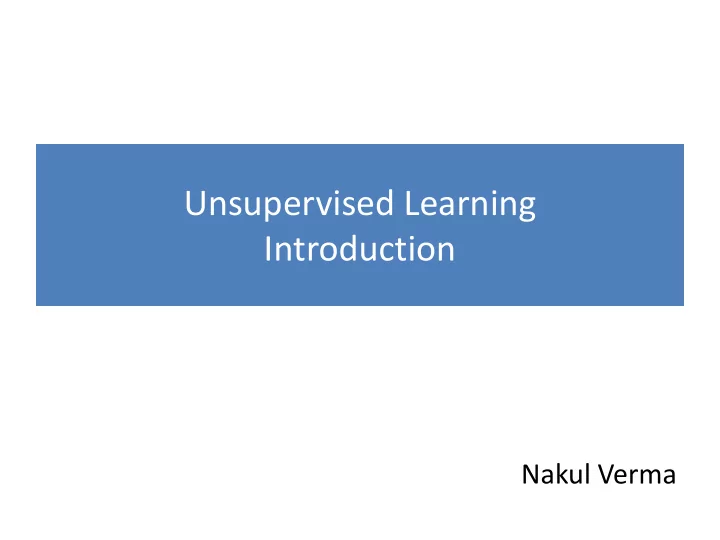

Unsupervised Learning Introduction Nakul Verma
Unsupervised Learning What can we learn from data when label information is not available?
Supervised learning framework Supervised learning Data: Assumption: there is a (relatively simple) function such that for most i Learning task: given n examples from the data, find an approximation Goal: gives mostly correct prediction on unseen examples Testing Phase Unlabeled test data (unseen / future data) Training Phase ‘classifier’ Labeled training data Learning ( n examples from data) Algorithm prediction
Unsupervised Learning Unsupervised learning Data: used for Assumption: there is an underlying structure in Exploratory data analysis Learning task: discover the structure given n examples from the data Goal: come up with a summary of the data using the discovered structure Partition the data into meaningful structures clustering Find a representation that Representation, retains important information, and suppresses Embeddings, irrelevant/noise information Dim. reduction Understand and model how Data analysis, data is distributed density estimation processing techniques that aid in ad-hoc data analysis and prediction techniques
A quick overview of the topics
Clustering • Centroid based methods (k-centers, k-means, k-mediods ,…) • Graph based methods (spectral clustering) • Hierarchical methods (Cluster trees, linkage based methods) • Density based methods (DBSCAN, watershed methods) • Bayesian methods ( Mixture modelling, Dirichlet and Chinese Restaurant processes ) • Axiomatic frameworks (impossibility results) [image from Sethi’s blog GSoC]
Representations • Metric Embeddings (metric spaces into L p spaces) • Representations in Euclidean spaces (text and speech embeddings, vision) • Representations in non-Euclidean spaces (hyperbolic embeddings) • Dim. reduction in Euclidean spaces • linear methods (PCA, ICA, factor analysis, dictionary learning) • non-linear methods (LLE, IsoMap, t-SNE, autoencoders) [image from Towards Datascience blog]
Data analysis and density estimation • Parametric and nonparametric density estimation ( classical techniques, VAEs GANs ) • Geometric data analysis (horseshoe effect, topological data analysis, etc.) [image from Towards Datascience blog]
Ad-hoc techniques • Organizing data for better prediction • Datastructures for nearest neighbors (Cover trees, LSH) • Datastructures for prediction (RPTrees)
This course: Goals • To study in detail various methodologies applied in an unsupervised learning task • Gain a deep understanding and working knowledge of the core theory behind the various approaches.
Prerequisites Mathematical prerequisites • Good understanding of: Prob and stats, Linear algebra, Calculus • Basic understanding of: Analysis • Nice to know: topology and diff. geom. (only for a few topics) Computational prerequisites • Basics of algorithms and datastructure design • Ability to program in a high-level language. Machine Learning prerequisites • Good understanding of: Nearest neighbors, decision trees, SVMs, learning theory, regression, latent variable models, neural networks
Administrivia Website: http://www.cs.columbia.edu/~ verma/classes/uml/ The team: Instructor: Nakul Verma (me) TA(s) Students: you! Evaluation: • Homeworks (50%) • Project (30%) • Class participation (5%) • Scribing and in class presentations (15%)
More details Homeworks (about 3 or 4 homeworks) • No late homework • Must type your homework (no handwritten homework) • Must include your name and UNI • Submit a pdf copy of the assignment via gradescope • All homeworks will be done individually • We encourage discussing the problems (piazza), but please don’t copy . Project (can/should be done in a group of 3-4 students) • Survey, implementation or some theory work on a specific topic in UL • Details will be sent out soon
More details Class participation & Scribing • Students should be prepared for class by reading the papers ahead of time • Should actively participate in the class discussions • Should present on one of the lecture topics covered in class • (scribing) Should prepare a preliminary set of notes before the lecture, and update these notes with the detailed discussions that happen in class
Announcement! • Visit the course website • Review the basics (prerequisites) • HW0 is out! • Sign up on Piazza & Gradescope
Let’s get started!
Recommend
More recommend